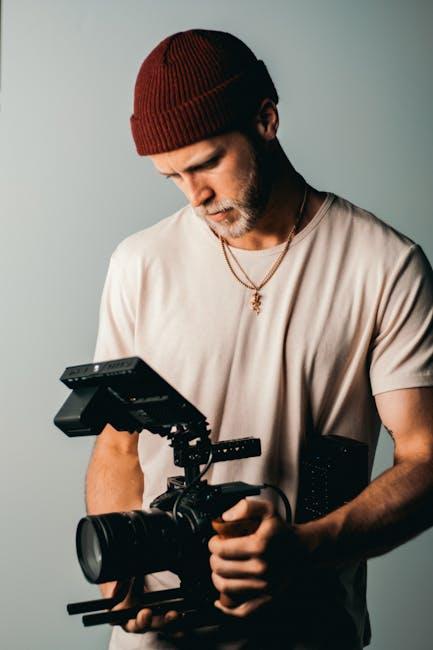In the world of filmmaking, the script is often regarded as the sacred blueprint—a meticulously crafted narrative that guides the director, crew, and cast toward a shared vision. Yet, within this structured realm, a question lingers like an unscripted whisper: should actors be allowed to improvise key scenes on set? This inquiry treads the delicate line between artistic freedom and narrative fidelity, inviting both fervent advocates and cautious skeptics to the dialogue. As we delve into this cinematic conundrum, we explore the potential for improvisation to infuse authenticity and spontaneity into a performance, while also considering the risks of deviating from a carefully plotted course. Join us as we navigate the creative crossroads where scripted precision meets the unpredictable art of improvisation.
The Art of Spontaneity Exploring Improvisation in Cinema
In the realm of filmmaking, allowing actors to improvise can inject an electrifying authenticity into key scenes. Improvisation offers a canvas for performers to explore their characters beyond the script, fostering moments of genuine emotion and unexpected brilliance. This creative freedom, however, can be a double-edged sword, potentially diverging from the director’s vision.
- Enhances Authenticity: Improvised scenes often feel more natural, capturing raw emotions that scripted dialogue might not.
- Encourages Collaboration: It fosters a collaborative environment, where actors and directors work together to shape the narrative organically.
- Risk of Inconsistency: Without careful guidance, spontaneity can lead to scenes that clash with the film’s tone or storyline.
Striking a balance between scripted precision and improvised spontaneity is key. While some directors thrive on the unpredictability, others may prefer the control of a tightly written script. Ultimately, the decision hinges on the creative goals of the project and the trust between the director and their cast.

Balancing Script and Creativity Weighing the Pros and Cons
- Structure vs. Spontaneity: The script is often considered the backbone of any film or television production, providing a well-defined path for actors to follow. It ensures consistency and alignment with the director’s vision. However, allowing actors to improvise can inject fresh energy and authenticity into a scene. The spontaneity of improvisation can lead to unexpected moments that resonate deeply with audiences, bringing a layer of realism that scripted lines might not achieve.
- Consistency vs. Creativity: One of the primary concerns with improvisation is maintaining consistency throughout the production. Key scenes often serve as pivotal moments in storytelling, and deviations from the script can lead to plot holes or confusion. On the other hand, actors who are given creative freedom may find new depths in their characters, unveiling layers of emotion and nuance that can enhance the narrative. Balancing these elements requires careful consideration and collaboration between the director, writers, and actors to ensure the story remains cohesive while embracing the potential for creative brilliance.

Directors Vision vs Actors Instinct Navigating Creative Tensions
In the dynamic world of filmmaking, the interplay between a director’s vision and an actor’s instinct often sparks creative tension. Directors meticulously craft their narratives, envisioning each scene with precision. They aim to maintain a cohesive story, ensuring every element aligns with the overall theme. Actors, on the other hand, bring their unique interpretations, infusing characters with depth and spontaneity. Their instincts can breathe life into a scene, adding unexpected layers and emotions.
Allowing actors to improvise can lead to memorable moments that might not have been captured otherwise. However, it also poses risks to the director’s intended storyline. Here are a few considerations when navigating these creative tensions:
- Flexibility: Balancing structure with freedom can lead to a richer, more authentic performance.
- Trust: Building a strong director-actor relationship fosters mutual respect and understanding.
- Collaboration: Open dialogues about the character and scene can lead to innovative solutions.
Ultimately, the synergy between a director’s guidance and an actor’s intuition can transform a good scene into a truly unforgettable one.

Guidelines for Successful Improvisation Crafting a Flexible Framework
Improvisation can breathe life into a scene, but it requires a structured approach to maintain narrative integrity. Establishing clear boundaries is essential. Directors should communicate the core objectives of the scene, ensuring that any deviations still align with the overall storyline. This allows actors to explore their creativity while staying true to the script’s intent.
- Character Consistency: Ensure that any improvised dialogue or actions remain true to the character’s established personality and arc.
- Scene Objectives: Clarify the scene’s purpose so that improvisation enhances rather than detracts from its impact.
- Collaboration: Foster a collaborative environment where actors, directors, and writers can discuss potential improvisations and their implications.
Feedback loops can also be valuable. After an improvised take, gather input from the cast and crew to assess whether the changes improve the scene. This iterative process allows for flexibility while safeguarding the film’s vision.

